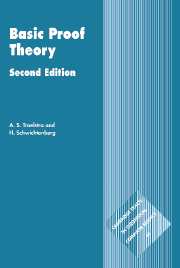Book contents
- Frontmatter
- Contents
- Preface
- 1 Introduction
- 2 N-systems and H-systems
- 3 Gentzen systems
- 4 Cut elimination with applications
- 5 Bounds and permutations
- 6 Normalization for natural deduction
- 7 Resolution
- 8 Categorical logic
- 9 Modal and linear logic
- 10 Proof theory of arithmetic
- 11 Second-order logic
- Solutions to selected exercises
- Bibliography
- Symbols and notations
- Index
6 - Normalization for natural deduction
Published online by Cambridge University Press: 05 June 2012
- Frontmatter
- Contents
- Preface
- 1 Introduction
- 2 N-systems and H-systems
- 3 Gentzen systems
- 4 Cut elimination with applications
- 5 Bounds and permutations
- 6 Normalization for natural deduction
- 7 Resolution
- 8 Categorical logic
- 9 Modal and linear logic
- 10 Proof theory of arithmetic
- 11 Second-order logic
- Solutions to selected exercises
- Bibliography
- Symbols and notations
- Index
Summary
We now embark on a more thorough study of natural deduction, normalization and the structure of normal derivations. We describe a simple normalization strategy w.r.t. a specific set of conversions which transforms every deduction in Ni into a deduction in normal form; moreover, for →Nm we prove that deductions are in fact strongly normalizable, i.e. every sequence of normalization steps terminates in a normal deduction, which is in fact unique.
As in the case of cut elimination, there is a hyperexponential upper bound on the rate of growth under normalization. From a suitable example we also easily obtain a hyperexponential lower bound. This still leaves open the possibility that each theorem might have at least some cutfree deduction of “modest” length; but this possibility is excluded by an example, due to Orevkov, of a sequence of statements Cn, n ∈ ℕ, with deductions linearly bounded by n, for which the minimum depth of arbitrary normal proofs has a hyperexponential lower bound.
This points to the very important role of indirect proof in mathematical reasoning: without indirect reasoning, exemplified by non-normal proofs, we cannot present proofs of manageable size for the Cn.
Conversions and normalization
In this and the next section we shall study the process of normalization for Ni, which corresponds to cut elimination for intuitionistic sequent calculi.
We shall assume, unless stated otherwise, that applications of ⊥i have atomic conclusions in the deductions we consider.
- Type
- Chapter
- Information
- Basic Proof Theory , pp. 178 - 229Publisher: Cambridge University PressPrint publication year: 2000



